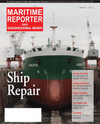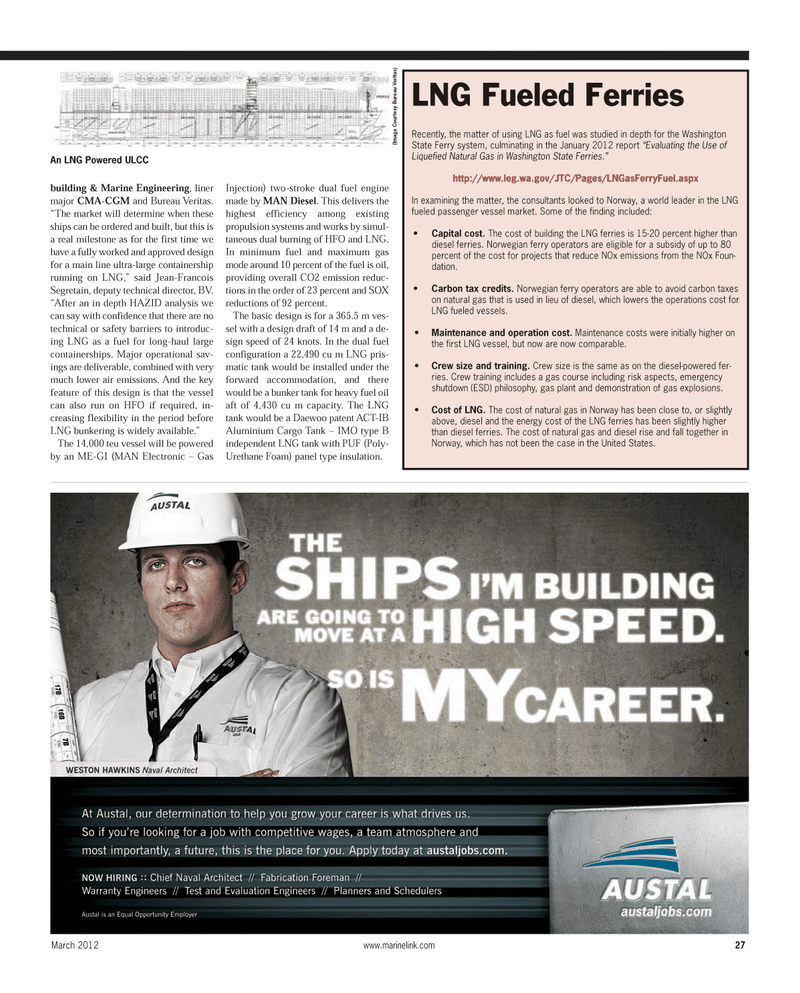
Page 27: of Maritime Reporter Magazine (March 2012)
The Ship Repair Edition
Read this page in Pdf, Flash or Html5 edition of March 2012 Maritime Reporter Magazine
building & Marine Engineering , linermajor CMA-CGMand Bureau Veritas. ?The market will determine when these ships can be ordered and built, but this is a real milestone as for the first time we have a fully worked and approved design for a main line ultra-large containership running on LNG,? said Jean-Francois Segretain, deputy technical director, BV. ?After an in depth HAZID analysis we can say with confidence that there are no technical or safety barriers to introduc-ing LNG as a fuel for long-haul large containerships. Major operational sav- ings are deliverable, combined with very much lower air emissions. And the key feature of this design is that the vessel can also run on HFO if required, in-creasing flexibility in the period before LNG bunkering is widely available.? The 14,000 teu vessel will be powered by an ME-GI (MAN Electronic ? GasInjection)two-stroke dual fuel engine made by MAN Diesel. This delivers the highest efficiency among existing propulsion systems and works by simul- taneous dual burning of HFO and LNG. In minimum fuel and maximum gas mode around 10 percent of the fuel is oil,providing overall CO2 emission reduc- tions in the order of 23 percent and SOX reductions of 92 percent.The basic design is for a 365.5 m ves- sel with a design draft of 14 m and a de-sign speed of 24 knots. In the dual fuelconfiguration a 22,490 cu m LNG pris- matic tank would be installed under the forward accommodation, and there would be a bunker tank for heavy fuel oil aft of 4,430 cu m capacity. The LNG tank would be a Daewoo patent ACT-IB Aluminium Cargo Tank ? IMO type B independent LNG tank with PUF (Poly-Urethane Foam) panel type insulation. March 2012 www.marinelink.com 27LNG Fueled Ferries Recently, the matter of using LNG as fuel was studied in depth for the Washington State Ferry system, culminating in the January 2012 report ?Evaluating the Use ofLiquefied Natural Gas in Washington State Ferries.? http://www.leg.wa.gov/JTC/Pages/LNGasFerryFuel.aspx In examining the matter, the consultants looked to Norway, a world leader in the LNG fueled passenger vessel market. Some of the finding included:Capital cost. The cost of building the LNG ferries is 15-20 percent higher than diesel ferries. Norwegian ferry operators are eligible for a subsidy of up to 80 percent of the cost for projects that reduce NOx emissions from the NOx Foun- dation. Carbon tax credits. Norwegian ferry operators are able to avoid carbon taxes on natural gas that is used in lieu of diesel, which lowers the operations cost forLNG fueled vessels.Maintenance and operation cost. Maintenance costs were initially higher on the first LNG vessel, but now are now comparable. Crew size and training. Crew size is the same as on the diesel-powered fer- ries. Crew training includes a gas course including risk aspects, emergency shutdown (ESD) philosophy, gas plant and demonstration of gas explosions. Cost of LNG. The cost of natural gas in Norway has been close to, or slightlyabove, diesel and the energy cost of the LNG ferries has been slightly higher than diesel ferries. The cost of natural gas and diesel rise and fall together inNorway, which has not been the case in the United States. An LNG Powered ULCC (Image Courtesy Bureau Veritas) MR March 12 # 4 (25-32):MR Template 3/6/2012 12:28 PM Page 27

 26
26

 28
28
